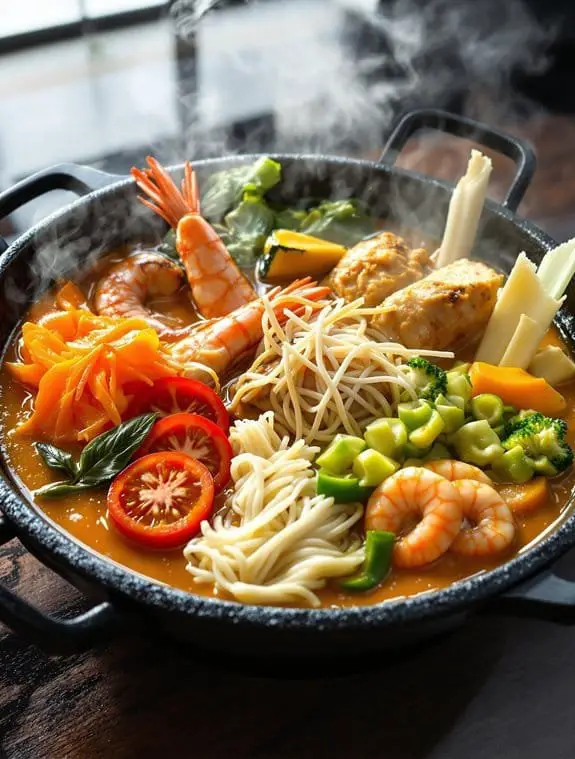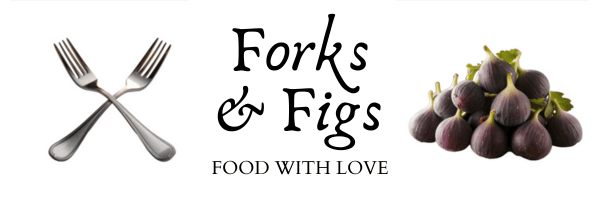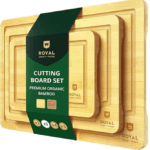Soul-Warming Japanese Curry Nabe Recipe

I’m convinced that Japanese curry nabe might just be the ultimate comfort food hack for busy weeknights. Think of it as a cozy hug in a pot, where tender chicken, plump shrimp, and colorful vegetables swim together in a rich, aromatic curry broth that’s practically begging for melted cheese on top. The best part? You can throw in whatever’s lurking in your fridge, and somehow it always works out perfectly.
Why You’ll Love this Soul-Warming Japanese Curry Nabe
When winter winds start howling and your soul craves something that’s basically a warm hug in a bowl, this Japanese curry nabe delivers comfort that’ll make you question why you ever bothered with regular soup.
I mean, where else can you throw chicken drumsticks, shrimp, and vegetables into one pot with curry spices and call it dinner? This isn’t your typical bland hotpot situation.
The curry powder transforms everything into something rich and satisfying, while the cheese melts in creating creamy pockets of pure happiness.
Plus, cleanup is minimal since everything cooks together.
What Ingredients are in Soul-Warming Japanese Curry Nabe?
This Japanese curry nabe brings together an impressive lineup of ingredients that somehow manage to play perfectly together in one cozy pot.
We’re talking about a mix that ranges from tender chicken drumsticks to plump shrimp, plus vegetables that soak up all those curry-spiced flavors like little flavor sponges.
The beauty of this ingredient list lies in its simplicity, really. You won’t need to hunt down obscure items at specialty stores or break the bank buying ingredients you’ll use once and forget about.
Most of these components are either pantry staples or things you can easily grab during your regular grocery run.
For the Curry Nabe:
- 600 ml water
- 5 g dried kelp (kombu)
- 4 chicken drumsticks
- 1 carrot, cut into thick rounds
- 4 slices kabocha squash
- 1 tbsp curry powder
- 1 tbsp Japanese dark soy sauce
- 1 tbsp sake
- 1 tbsp mirin
- ½ tbsp chicken bouillon powder
- 1 tsp chili bean sauce
- 6 peeled black tiger shrimp, tail on
- 50 g shimeji mushrooms
- 2 leaves Napa cabbage, roughly cut
- 1 Japanese leek, diagonally sliced
- 1 green bell pepper, cut into bite-size pieces
- 4 tbsp shredded melting cheese
- 1 tomato, cross scored
- 2 portions cooked ramen noodles
Ingredient Notes and Substitutions
The kombu might seem like an optional fancy touch, but trust me on this one.
This dried kelp creates the foundation of umami that makes everything else taste like it belongs together. You can find it in the Asian section of most grocery stores, and one package lasts forever.
Kabocha squash adds a subtle sweetness that balances the curry spices beautifully.
If you can’t track down kabocha, butternut squash works as a decent substitute, though it won’t have quite the same creamy texture. Cut it into similar-sized pieces so everything cooks evenly.
Japanese leek differs slightly from regular leeks in that it’s a bit milder and sweeter, but honestly, regular leeks work just fine here.
Even green onions can pinch-hit if you’re in a bind, though you’ll want to use more of them since they’re smaller.
The shredded melting cheese doesn’t need to be anything fancy.
Regular mozzarella or even a mild cheddar blend works perfectly. The goal is something that melts smoothly and creates those satisfying cheese pulls when you’re fishing ingredients out of the pot.
How to Make this Soul-Warming Japanese Curry Nabe

Making this curry nabe feels like conducting a cozy little orchestra where every ingredient gets its moment to shine. The whole process builds layers of flavor that’ll have your kitchen smelling like the most inviting Japanese restaurant you’ve ever walked into.
Building Your Flavor Foundation
Start by creating your dashi base with 600 ml water and 5 g dried kelp (kombu). Let these simmer together gently, and don’t rush this step. The kombu needs time to release all that oceanic umami goodness that makes Japanese cooking so mysteriously satisfying. Think of this as setting the stage for everything else that’s about to happen.
Once your broth has that subtle kelp flavor going on, it’s time to add the heartier ingredients that need more cooking time. Drop in your 4 chicken drumsticks, 1 carrot cut into thick rounds, and 4 slices of kabocha squash. These need to cook until tender, which usually takes about 15-20 minutes depending on the size of your pieces.
Bringing in the Spice and Soul
Here’s where things get interesting. Stir in your flavor powerhouses: 1 tbsp curry powder, 1 tbsp Japanese dark soy sauce, 1 tbsp sake, 1 tbsp mirin, ½ tbsp chicken bouillon powder, and 1 tsp chili bean sauce.
Watch as your clear broth transforms into something golden and aromatic that makes you want to stick your face right over the pot and inhale deeply. The curry powder does most of the heavy lifting here, but that chili bean sauce adds a subtle heat that sneaks up on you in the best possible way.
Don’t worry if it seems like a lot of different seasonings; they all play together beautifully once everything starts bubbling.
Adding the Quick-Cooking Stars
Now comes the fun part where you get to pile in all the ingredients that cook quickly. Add your 6 peeled black tiger shrimp (keeping those tails on for presentation), 50 g shimeji mushrooms, 2 roughly cut Napa cabbage leaves, 1 diagonally sliced Japanese leek, and 1 green bell pepper cut into bite-size pieces.
Keep everything cooking until the vegetables reach that perfect tender-crisp stage and your shrimp have turned that gorgeous pink color that screams “I’m done and delicious.” This usually takes about 5-7 minutes, but keep an eye on those shrimp since they go from perfect to rubbery faster than you’d think.
The Grand Finale
For the final flourish, add your 1 cross-scored tomato and 4 tbsp of shredded melting cheese. The tomato will start breaking down slightly, adding this lovely acidic brightness that cuts through all the rich curry flavors.
Meanwhile, that cheese creates these irresistible melty pockets throughout the broth. Once everything’s heated through and the cheese has melted into stringy perfection, you can serve it up with those 2 portions of cooked ramen noodles.
The noodles soak up the curry broth like little flavor sponges, making each bite a perfect combination of spice, umami, and comfort. The whole process feels almost meditative, watching all these different ingredients come together into something that’s way more than the sum of its parts.
Plus, there’s something deeply satisfying about creating a one-pot meal that looks this impressive but doesn’t require any fancy techniques or equipment.
Soul-Warming Japanese Curry Nabe Substitutions and Variations
Since you probably don’t have a Japanese grocery store on every corner, let’s talk about how to make this curry nabe work with whatever’s hanging out in your fridge right now.
Can’t find kombu? Regular chicken broth works fine.
No kabocha squash? Sweet potato or butternut squash will do the trick.
Swap those black tiger shrimp for whatever seafood you’ve got, or skip it entirely if you’re keeping things meaty.
The vegetables are totally flexible too. Broccoli, snap peas, or regular mushrooms all play nicely with curry flavors.
Even frozen mixed vegetables work when I’m feeling lazy.
What to Serve with Soul-Warming Japanese Curry Nabe
Comfort food demands equally comforting sides, and Japanese curry nabe pairs beautifully with simple, satisfying accompaniments that won’t compete with the pot’s bold flavors.
I like steamed white rice on the side – it soaks up those gorgeous curry juices perfectly.
Pickled vegetables add brightness that cuts through richness. Think quick cucumber pickles or store-bought daikon.
Gyoza work wonderfully too, crispy and golden. Their savory filling complements curry’s warmth without overwhelming your palate.
For drinks? Green tea feels traditional, but honestly, cold beer hits different with spicy curry heat.
Sometimes simple choices make the biggest impact on your dining experience.
Final Thoughts
Japanese curry nabe brings together everything I love about winter cooking – warmth, flexibility, and that magical moment when everyone gathers around one bubbling pot.
I truly believe there’s something almost meditative about watching those curry-scented bubbles rise to the surface while good people crowd around your table.
This recipe gives you permission to improvise. Got leftover vegetables lurking in your fridge? Toss them in. Prefer beef over chicken? Go for it. The beauty lies in its forgiving nature.
Trust me, once you master this comforting dish, you’ll find yourself craving those cozy nabe nights all season long.

Japanese Curry Nabe
Ingredients
For the Broth:
- 600 ml water
- 5 g dried kelp kombu
- 1 tbsp curry powder
- 1 tbsp Japanese dark soy sauce
- 1 tbsp sake
- 1 tbsp mirin
- ½ tbsp chicken bouillon powder
- 1 tsp chili bean sauce
For the Hotpot:
- 4 chicken drumsticks
- 1 carrot cut into thick rounds
- 4 slices kabocha squash
- 6 peeled black tiger shrimp tail on
- 50 g shimeji mushrooms
- 2 leaves Napa cabbage roughly cut
- 1 Japanese leek diagonally sliced
- 1 green bell pepper cut into bite-size pieces
- 4 tbsp shredded melting cheese
- 1 tomato cross scored
- 2 portions cooked ramen noodles
Instructions
- Simmer water and kombu in a large pot for 10 minutes to create a flavorful dashi broth.
- Add chicken drumsticks, carrot, and kabocha squash to the broth. Cook for 15-20 minutes until chicken is tender and vegetables are fork-tender.
- Stir in curry powder, Japanese dark soy sauce, sake, mirin, chicken bouillon powder, and chili bean sauce. Mix well to combine all seasonings.
- Add shrimp, shimeji mushrooms, Napa cabbage, Japanese leek, and bell pepper to the pot. Cook for 5-8 minutes until vegetables are soft and shrimp turn pink and are fully cooked.
- Add the cross-scored tomato and shredded cheese to the pot. Allow cheese to melt and tomato to warm through.
- Serve immediately with cooked ramen noodles on the side for dipping and eating alongside the curry nabe.
Notes
Nutrition
Frequently Asked Questions
Can I Make This Curry Nabe Recipe Vegetarian or Vegan?
I can easily make this vegetarian by replacing chicken drumsticks with firm tofu and using vegetable broth instead of kombu-chicken base. For vegan, I’ll substitute dairy cheese with nutritional yeast.
How Long Does Leftover Curry Nabe Keep in the Refrigerator?
I’d store leftover curry nabe in the refrigerator for up to three days. I’ll make sure it’s completely cooled before refrigerating and reheat it thoroughly before serving again.
What Type of Pot or Equipment Is Best for Making Nabe?
I recommend using a traditional Japanese donabe clay pot or a wide, shallow stainless steel pot. Both distribute heat evenly and allow everyone to gather around for communal cooking at the table.
Can I Freeze Curry Nabe for Meal Prep Purposes?
I don’t recommend freezing curry nabe since the vegetables will become mushy and the broth’s texture changes. Instead, I’d suggest making smaller batches or freezing individual components separately before assembly.
Is Curry Nabe Spicy and Can I Adjust the Heat Level?
Curry nabe isn’t very spicy since it uses mild curry powder. I can easily adjust the heat by increasing chili bean sauce, adding fresh chilies, or using hot curry powder instead of regular.



